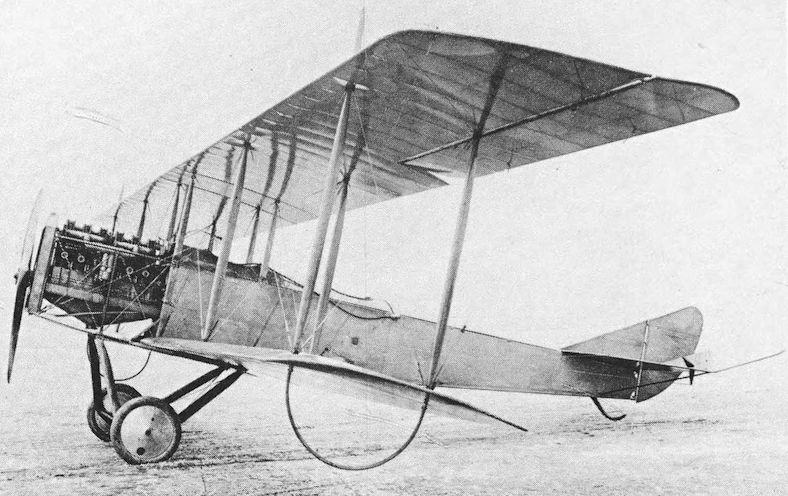
Описание
Страна: Канада
Год: 1916
K.Molson, H.Taylor Canadian Aircraft since 1909 (Putnam)
M.F.P. (Polson) B-2 and C Biplanes
In 1915 Walter H. Phipps designed a family of aircraft that was unusual for the time, especially so in North America in that the structure was largely of steel. The family consisted of a fast single-seat scout (presumably the Model A); an unequalspan two-seat biplane, the Model B-2; an equal-span two-seat biplane, the Model C; and a two-seat scout of 38 ft (11-58 m) span powered by a 300 hp Dusenberg V-12 engine. All could be used as seaplanes when fitted with twin single-step wooden floats, and all, except the Model A, were to use the same fuselage. In the event, only the B-2 and C were made and neither was ever fitted with floats.
To develop and market the aircraft, Phipps formed a group of three, Col J. B. Miller, President of Polson Iron Works Ltd of Toronto, Walter L. Fairchild, and himself, to become the M.F.P, Aero Sales Corp of New York City, the initials having been taken from the names of the three men. The aircraft were to be made by the Polson Iron Works and were frequently referred to by the Polson name rather than the designated M.F.P. The Polson Co was the main financial backer, and one reference states that M.F.P. Aero Sales was a subsidiary of the Polson company, whose normal business was in structural steel construction, marine engines and shipbuilding.
Phipps had taken some experienced staff to Toronto to introduce the Polson company to aeronautical practices, including Jean A. Roche who was later well known as the designer of the successful Aeronca C-2 light aircraft.
Construction began with the B-2. Its fuselage was made of steel tubing which was joined by special standardized steel clamps and wire braced. The wings had tubular steel spars and conventional wooden ribs of Eiffel 36 section. Interchangeability of parts was advertised as a particular feature. The University of Toronto made physical tests on the main fittings, spars and struts, which seems to be the University’s first direct involvement in aeronautical work. Deperdussin flight controls were fitted. The powerplant was a 125 hp Hall-Scott L-5, and as an alternative, a new engine under development, a 160 hp Bournonville was specified. An unusually large fuel tank of 60 US gal (227 litres) capacity was fitted between the cockpits, giving an endurance of six hours.
The machine was first flown, on wheels, from the ice of Toronto Bay by John Guy Gilpatric on 29 March, 1916. It was then shipped to Mineola on Long Island, where Gilpatric continued as its pilot. On 2 June, Charles F. Niles, the well-known aerobatic pilot, took it up for a ‘record climb’ of 3,500 ft (1,067 m) in four minutes.
During the summer, articles and advertisements continued to promote the B-2 as a ‘steel warplane’ and a ‘steel battleplane’, but no armament was ever mentioned in connection with the type and, as far as is known, no official attempt was made to sell it to the United States or Canadian Governments, but it seems likely that informal demonstrations were given at Mineola.
Equal-span wings with ailerons on both upper and lower sets were sent to Mineola to convert the B-2 into the Model C, on which side-radiators were fitted and the nose tapered. Nothing more is known of the Model C and its career, and the whole M.F.P. scheme was abandoned. As far as can be determined only the one B-2 was completed and converted to the Model C.
Earl S. Daugherty of Long Beach, was operating a Curtiss OX-5-powered Polson biplane just after the first war but this was built locally by Thor Polson, no relation of the M.F.P. Polson.
Model B-2
One 125 hp Hall-Scott L-5. Span, upper 45 ft (13-71 m), lower 36ft (10-97m); length 26ft 6in (8-08m); height 10ft (3-05m) approx; wing area 410 sq ft (38-09sqm). Empty weight 1,3701b (622kg); loaded weight 2,270lb (1,031 kg). Maximum speed 85 mph (136-8 km/h); climb 1,000 ft (305 m) in 1-33min.
Model C
One 125hp Hall-Scott L-5. Span 38ft Win (11 -83 m); length 26ft 6in (8-08m); height 10ft (3-05m) approx; wing area 393sqft (36-51sqm). Empty weight 1,420lb (645kg); loaded weight 2,320lb (1,053 kg). Maximum speed 95 mph (152-8 km/h).
Описание:
- K.Molson, H.Taylor Canadian Aircraft since 1909 (Putnam)
- Журнал Flight
Фотографии
-
K.Molson, H.Taylor - Canadian Aircraft since 1909 /Putnam/
M.F.P. B-2 on the ice of Toronto Bay, on 29 March, 1916.
-
Журнал - Flight за 1916 г.
M.F.P. B-2 on the ice in Toronto Bay on 29 March 1916
-
K.Molson, H.Taylor - Canadian Aircraft since 1909 /Putnam/
M.F.P. B-2 at Mineola, Long Island.
-
Журнал - Flight за 1916 г.
Front view of the M.F.P. model B 2 biplane.
-
Журнал - Flight за 1916 г.
Rear view of the M.F.P. model B 2 biplane.
-
K.Molson, H.Taylor - Canadian Aircraft since 1909 /Putnam/
The Polson Model C. The side radiators can be seen.
-
Журнал - Flight за 1916 г.
Two views of the M.F.P. biplane in flight.
-
Журнал - Flight за 1916 г.
THE M.F.P. MODEL B 2 BIPLANE - Three views showing the construction of the fuselage and main planes.
-
Форум - Breguet's Aircraft Challenge /WWW/
Winzen and his M.F.P. biplane, after he crashed it into some woods.
-
Журнал - Flight за 1916 г.
THE M.F.P. MODEL B 2 BIPLANE. - Plan, side and front elevation to scale.










